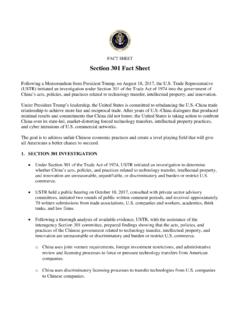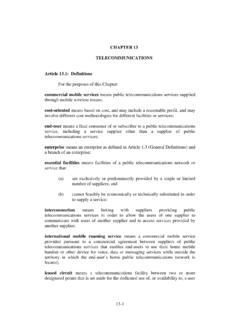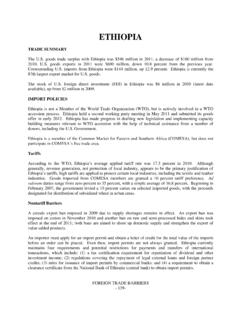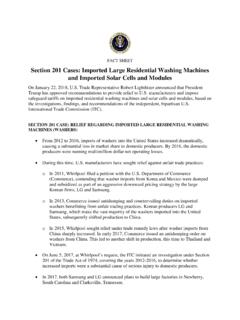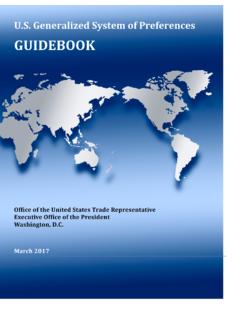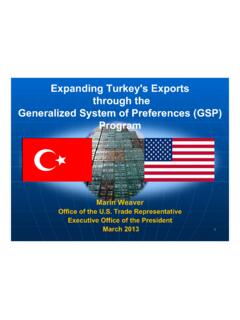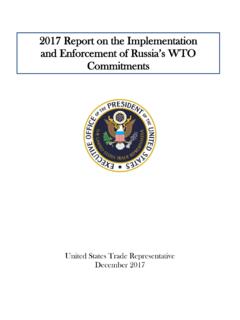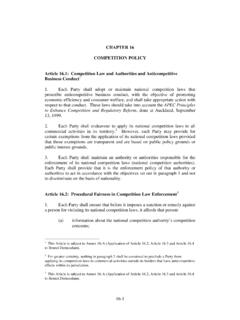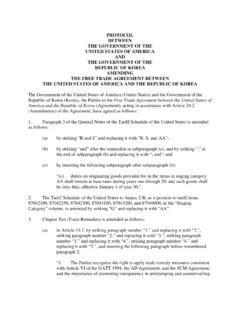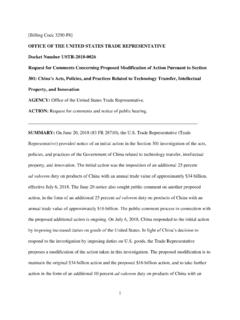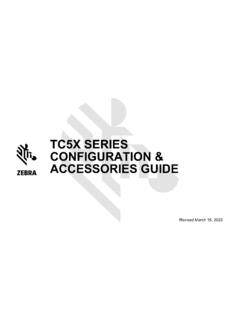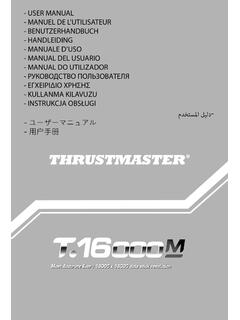Transcription of CHAPTER SIX RULES OF ORIGIN AND ORIGIN PROCEDURES
1 6-1 CHAPTER SIX RULES OF ORIGIN AND ORIGIN PROCEDURES Section A: RULES of ORIGIN ARTICLE : ORIGINATING GOODS1 Except as otherwise provided in this CHAPTER , each Party shall provide that a good is originating where it is: (a) a good wholly obtained or produced entirely in the territory of one or both of the Parties; (b) produced entirely in the territory of one or both of the Parties and (i) each of the non-originating materials used in the production of the good undergoes an applicable change in tariff classification specified in Annex 4-A (Specific RULES of ORIGIN for Textile or Apparel Goods) or Annex 6-A, or (ii) the good otherwise satisfies any applicable regional value content or other requirements specified in Annex 4-A or Annex 6-A, and the good satisfies all other applicable requirements of this CHAPTER ; or (c) produced entirely in the territory of one or both of the Parties exclusively from originating materials.
2 ARTICLE : REGIONAL VALUE CONTENT 1. Where Annex 6-A specifies a regional value content test to determine whether a good is originating, each Party shall provide that the importer, exporter, or producer may calculate regional value content based on one or the other of the following methods: (a) Method Based on Value of Non-Originating Materials (Build-down Method) RVC = AV - VNM x 100 AV (b) Method Based on Value of Originating Materials (Build-up Method) RVC = VOM x 100 AV 1 For greater certainty, whether a good is originating is not determinative of whether the good is also admissible. 6-2 where, RVC is the regional value content, expressed as a percentage; AV is the adjusted value of the good; VNM is the value of non-originating materials, other than indirect materials, acquired and used by the producer in the production of the good; VNM does not include the value of a material that is self-produced; and VOM is the value of originating materials, other than indirect materials, acquired or self- produced and used by the producer in the production of the good.
3 2. Each Party shall provide that all costs considered for the calculation of regional value content shall be recorded and maintained in conformity with the Generally Accepted Accounting Principles applicable in the territory of the Party where the good is produced. 3. Where Annex 6-A specifies a regional value content test to determine if an automotive good2 is originating, each Party shall provide that the importer, exporter, or producer may calculate the regional value content of that good as provided in paragraph 1 or based on the following method: Net Cost Method (for Automotive Goods) RVC = NC - VNM x 100 NC where, RVC is the regional value content, expressed as a percentage; NC is the net cost of the good; and VNM is the value of non-originating materials, other than indirect materials, acquired and used by the producer in the production of the good; VNM does not include the value of a material that is self-produced.
4 4. Each Party shall provide that, for purposes of the regional value content method in paragraph 3, the importer, exporter, or producer may use a calculation averaged over the producer s fiscal year, using any one of the following categories, on the basis of all motor vehicles in the category or only those motor vehicles in the category that are exported to the territory of the other Party: 2 Paragraph 3 applies solely to goods classified under the following HS headings and subheadings: through (engines), (diesel engines for vehicles), (parts of engines), through (motor vehicles), (chassis), (bodies), and (motor vehicle parts). 6-3 (a) the same model line of motor vehicles in the same class of vehicles produced in the same plant in the territory of a Party; (b) the same class of motor vehicles produced in the same plant in the territory of a Party; or (c) the same model line of motor vehicles produced in the territory of a Party.
5 5. Each Party shall provide that, for purposes of calculating regional value content under paragraph 3 for automotive materials3 produced in the same plant, an importer, exporter, or producer may use a calculation: (a) averaged, (i) over the fiscal year of the motor vehicle producer to whom the good is sold; (ii) over any quarter or month; or (iii) over the fiscal year of the automotive materials producer, provided that the good was produced during the fiscal year, quarter, or month forming the basis for the calculation; (b) in which the average in subparagraph (a) is calculated separately for such goods sold to one or more motor vehicle producers; or (c) in which the average in subparagraph (a) or (b) is calculated separately for those goods that are exported to the territory of the other Party. ARTICLE : VALUE OF MATERIALS Each Party shall provide that, for purposes of Articles and , the value of a material shall be: (a) for a material imported by the producer of the good, the adjusted value of the material; (b) for a material acquired by the producer in the territory where the good is produced, the value, determined in accordance with Articles 1 through 8, Article 15, and the corresponding interpretative notes of the Customs Valuation Agreement, , in the same manner as for imported goods, with such reasonable modifications as may be required due to the absence of an importation by the producer; or 3 Paragraph 5 applies solely to automotive materials classified in the following HS headings and subheadings: through (engines), (diesel engines for vehicles), (parts of engines), (chassis), (bodies), and (motor vehicle parts).
6 Transportation. 6-4 (c) for a material that is self-produced, (i) all the costs incurred in the production of the material, including general expenses; and (ii) an amount for profit equivalent to the profit added in the normal course of trade. ARTICLE : FURTHER ADJUSTMENTS TO THE VALUE OF MATERIALS 1. Each Party shall provide that, for originating materials, the following expenses, where not included under Article , may be added to the value of the material: (a) the costs of freight, insurance, packing, and all other costs incurred in transporting the material within a Party s territory or between the territories of the Parties to the location of the producer; (b) duties, taxes, and customs brokerage fees on the material paid in the territory of one or both of the Parties, other than duties and taxes that are waived, refunded, refundable, or otherwise recoverable, including credit against duty or tax paid or payable; and (c) the cost of waste and spoilage resulting from the use of the material in the production of the good, less the value of renewable scrap or by-product.
7 2. Each Party shall provide that, for non-originating materials, the following expenses, where included under Article , may be deducted from the value of the material: (a) the costs of freight, insurance, packing, and all other costs incurred in transporting the material within a Party s territory or between the territories of the Parties to the location of the producer; (b) duties, taxes, and customs brokerage fees on the material paid in the territory of one or both of the Parties, other than duties and taxes that are waived, refunded, refundable, or otherwise recoverable, including credit against duty or tax paid or payable; (c) the cost of waste and spoilage resulting from the use of the material in the production of the good, less the value of renewable scrap or by-product; and (d) the cost of originating materials used in the production of the non-originating material in the territory of a 4 For greater certainty and for purposes of paragraphs 1(a) and 2(a) of Article , costs of freight includes the costs of all types of freight, including in-land freight incurred within a Party s territory, regardless of the mode of 6-5 ARTICLE : ACCUMULATION 1.
8 Each Party shall provide that originating goods or materials of one Party, incorporated into a good in the territory of the other Party, shall be considered to originate in the territory of the other Party. 2. Each Party shall provide that a good is originating where the good is produced in the territory of one or both of the Parties by one or more producers, provided that the good satisfies the requirements in Article and all other applicable requirements in this CHAPTER . ARTICLE : DE MINIMIS 1. Except as provided in Annex 6-B, each Party shall provide that a good that does not undergo a change in tariff classification pursuant to Annex 6-A is nonetheless originating if the value of all non-originating materials that have been used in the production of the good and do not undergo the applicable change in tariff classification does not exceed ten percent of the adjusted value of the good, provided that the value of such non-originating materials shall be included in the value of non-originating materials for any applicable regional value content requirement and that the good meets all other applicable requirements in this CHAPTER .
9 2. With respect to a textile or apparel good, Article ( RULES of ORIGIN and Related Matters) applies in place of paragraph 1. ARTICLE : FUNGIBLE GOODS AND MATERIALS5 1. Each Party shall provide that an importer claiming preferential tariff treatment for a good may claim that a fungible good or material is originating where the importer, exporter, or producer has: (a) physically segregated each fungible good or material; or (b) used any inventory management method, such as averaging, last-in-first-out (LIFO) or first-in-first-out (FIFO), recognized in the Generally Accepted Accounting Principles of the Party in which the production is performed or otherwise accepted by the Party in which the production is performed. 2. Each Party shall provide that the inventory management method selected under paragraph 1 for a particular fungible good or material shall continue to be used for that good or material throughout the fiscal year of the person that selected the inventory management method.
10 ARTICLE : accessories , spare PARTS, AND TOOLS 5 Nothing in Article shall be construed to prevent a Party from requiring an importer to identify by percentage the country or countries of ORIGIN of fungible goods. 6-6 1. Each Party shall provide that a good s standard accessories , spare parts, or tools delivered with the good shall be considered originating goods if the good is an originating good and shall be disregarded in determining whether all the non-originating materials used in the production of the good undergo the applicable change in tariff classification, provided that: (a) the accessories , spare parts, or tools are classified with and not invoiced separately from the good; and (b) the quantities and value of the accessories , spare parts, or tools are customary for the good. 2. If a good is subject to a regional value content requirement, the value of the accessories , spare parts, or tools described in paragraph 1 shall be taken into account as originating or non- originating materials, as the case may be, in calculating the regional value content of the good.
